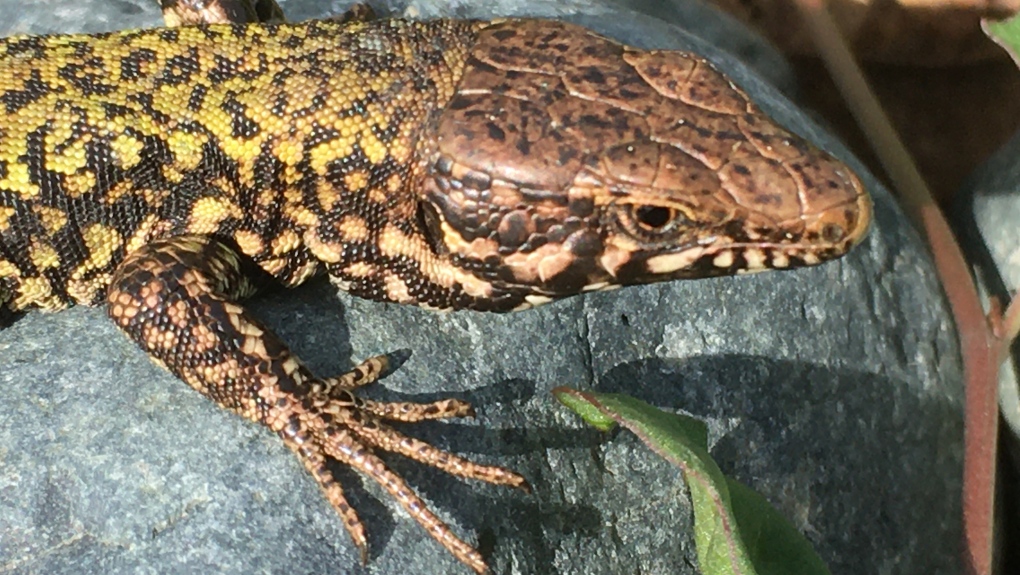Growing lizard population on Vancouver Island concerns museum curator
 Originally from Central Italy, at least 12 common wall lizards were released from a small private zoo on Vancouver Island in 1970.
Originally from Central Italy, at least 12 common wall lizards were released from a small private zoo on Vancouver Island in 1970.
What began as someone’s pet more than 50 years ago in Saanich has now ballooned into an invasive species spreading across the South Island and even the Lower Mainland.
Common wall lizards now have a local population of between 500,000 and 700,000 and growing, according to Gavin Hanke, curator of vertebrate zoology at the Royal BC Museum in Victoria.
“This is a lizard that shouldn’t be here,” says Hanke, “People shouldn’t be letting their pets go, but this is precisely what happened here.”
The small lizards can be seen sunning themselves on rocks and logs in neighbourhoods throughout the region, but are very skittish when you get near them and will usually zip away.
Originally from Central Italy, they were introduced to Vancouver Island in 1967. In 1970, at least 12 lizards were released from a small private zoo, and since then the population has exploded.
They have spread from the Capital Region to Pender, Salt Spring and Denman islands, as well as a recent population discovery south of Chilliwack.
The wall lizards have done extremely well here in a climate perfectly suited to their needs. The winters aren’t too cold, summers are fairly hot and there are lots of places for them to live in amongst rocks, logs and gardens.
“Their impact we have yet to really discover – on insects, spiders and pollinators here on the Island,” says Hanke.
“We have photographs of them eating termites, ants, wasps,” the curator adds. “They’ll eat honey bees, probably… We have records of them eating mason bees, bumble bees and they will even eat each other.”
The biggest lizard documented locally was 21 centimetres long, but they can range in size depending on age and whether their tails have been damaged by predators like cats and some birds.
There have been no attempts to eradicate the invasive lizards, according to Hanke. From Sidney to Metchosin, it’s probably too late to even try due to their large populations.
There is still a chance to eradicate them on the Gulf Islands, farther up Vancouver Island and on the Lower Mainland, but there is no official plan in place to do so.
Hanke spends hours studying the wall lizards in his own yard and neighbourhood not far from the Cedar Hill Recreation Centre in Saanich.
The lizards do not cause any physical damage to their habitat but do leave poop on sidewalks, decks and patios.
Hanke is tracking lizard sightings on an a website called iNaturalist. Readers can take a picture of a wall lizard and upload it to the site where the species’ spread can be tracked.
It’s not known yet if the invasive lizards are conflicting with the province’s homegrown lizards.
Native to B.C. is the northern alligator lizard, which is bigger than the common wall lizard but has shorter legs. They can be found on the North and Central Island and on the Saanich peninsula.
CTVNews.ca Top Stories

BREAKING 'They alone are responsible': No deal yet in Canada Post strike
The Canada Post strike is expected to continue as parties remain 'too far apart on critical issues' to reach a deal, according to Labour Minister Steven MacKinnon.
Hyundai recalling hundreds of thousands of cars and SUVs in Canada, U.S.
Hyundai is recalling hundreds of thousands of SUVs and small cars in the U.S. and Canada because the rearview camera image may not show up on the screens.
Man arrested at LAX after allegedly checking suitcases filled with over 70 pounds of meth-caked clothing
A California man was arrested at Los Angeles International Airport after he allegedly tried to check two suitcases containing more than 70 pounds of clothing caked in methamphetamine – including a cow pajama onesie – on a flight to Australia, federal prosecutors said Tuesday.
Is it worth ordering from small businesses during the Canada Post strike?
Supporters of mom-and-pop shops may be worried they won't get their packages during the Canada Post strike, but a small business industry group is encouraging people to not rule them out during their holiday shopping.
Trump transition says Cabinet picks, appointees were targeted by bomb threats, swatting attacks
Several of President-elect Donald Trump's Cabinet picks and appointees have been targeted by bomb threats and 'swatting attacks,' Trump's transition said Wednesday.
W5 Investigates Canada's least wanted man: A family's long and lonely fight to bring their son home from Syria
Counterterrorism experts and humanitarian groups are urging countries to repatriate suspected ISIS members, as one family tells CTV W5 about their long and lonely fight to bring their son home from Syria.
Baby boy allegedly killed by Toronto mother identified
An infant who police say was killed by their mother in midtown Toronto last week has been identified by police.
$100 million up for grabs after no Lotto Max grand prize winner Tuesday
An estimated $100 million is up for grabs, including an $80-million Lotto Max jackpot, after Tuesday night’s Lotto Max draw ended without a grand prize winner.
A Massachusetts man wrongfully convicted of murder was awarded $13 million. He won't get all of it
For the nearly three decades that he was behind bars, Michael Sullivan's mother and four siblings died, his girlfriend moved on with her life and he was badly beaten in several prison attacks. All for a murder he long insisted he never committed.





























